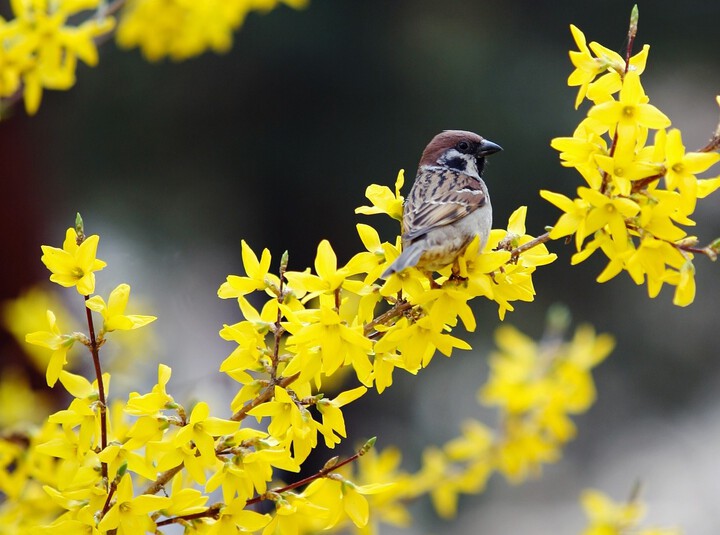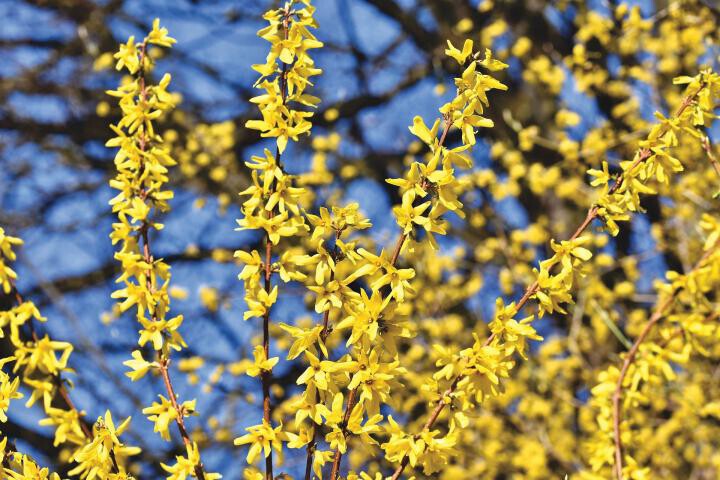The bright yellow flowers of the forsythia bush are one of the earliest blooms of spring, adding cheerful color to the still-sleepy landscape. Learn all about planting, growing, and caring for forsythia!
ABOUT FORSYTHIA BUSHES
Forsythia are deciduous, fast-growing, adaptable shrubs known for their cheery yellow blooms in early spring. In full flower, they’re hard to miss!
Although this shrub has become naturalized in much of Europe and North America, its ancestors hail mostly from East Asia—namely China and the Korean Peninsula—as well as one species from Europe.
As landscape plants, forsythia are suitable for planting in a good part of the continental United States; species and hybrid crosses are hardy from Zone 3 to Zone 8. See our Recommended Varieties below.
The forsythia shrub not only makes a vigorous border or backdrop for any yard, but also attracts bees, birds, and butterflies. Their long, arching branches can give them a wild look, but a good pruning will keep them in check.

PLANTING
WHEN TO PLANT FORSYTHIA BUSHES
The best time to plant forsythia is in the fall, while the plant is dormant.
CHOOSING AND PREPARING A PLANTING SITE
Select a spot in full sun where the shrub will have plenty of room in which to grow and expand. Depending on the cultivar, the shrub may reach up to 10 feet in height and 12 feet in diameter, so plan accordingly—or plan to prune regularly.
Forsythia will adapt to most soils, though they prefer loose, well-draining soil.
They do best in soils with a pH that ranges from about 7.0 to 8.0 (neutral to slightly alkaline).
HOW TO PLANT FORSYTHIA BUSHES
Dig a hole at least 2 times wider than the root ball.
Make sure that the top of the root ball is at ground level.
Pack the soil firmly around the roots.
Water deeply at the time of planting.
CARE
HOW TO CARE FOR FORSYTHIA BUSHES
Other than a yearly pruning, forsythia do not require much maintenance.
Apply a fertilizer high in phosphorus in early spring each year.
Softwood forsythia cuttings taken in late spring to early summer will root readily, allowing for easy propogation.
HOW TO PRUNE FORSYTHIA BUSHES
Forsythia are spring-blooming shrubs that bloom on old wood (last year’s growth). Read all about pruning shrubs here.
Prune the shrub in the spring—right after it has bloomed—in order to avoid cutting off next year’s buds, which will develop in the subsequent summer.
Remove older branches by cutting them off at the ground.
Later in the spring, new growth can be trimmed back to the nearest joint, if desired. Keep in mind that forsythia blooms on old wood, so this year’s growth will produce flowers next spring.
Old, neglected forsythias can be rejuvenated by pruning them back to within 3 to 4 inches of the ground in late winter or early spring. They’ll produce new growth as temperatures warm and days lengthen.

PESTS/DISEASES
This hardy shrub rarely experiences serious damage from insect pests or diseases.
HARVEST/STORAGE
FORCING FORSYTHIA BLOOMS INDOORS
To bring spring colors into your home, try forcing forsythia indoors! Simply prune off branches in late winter or early spring and set them in water. They should bloom within a week.
RECOMMENDED VARIETIES
There are about 11 species of forsythia and they are primarily native to eastern Asia, with one species from Europe. Forsythia suspensa and F. viridissima were the first to be brought from Asia to Europe. Forsythia × intermedia is a hybrid of these species that was introduced in Europe about 1880.
There are many Forsythia cultivars available, some as tall as 10 feet and others (dwarf varieties) barely reaching 4 feet tall.
‘Lynwood Gold’ and ‘Spring Glory’ are hardy to -10°F.
‘Meadowlark’ is hardy to -30°F. The flowers are the classic bright yellow.
‘Sunrise’ is a compact hardy cultivar. The shrub is covered with small yellow flowers in early spring.
‘Fiesta’ is a compact 3 to 4 feet tall shrub with variegated foliage. Leaves are green with yellow centers.
‘Happy Centennial’ is a low-growing cultivar developed in Canada, with light yellow flowers.
WIT & WISDOM
One old-time saying is to plant peas when the forsythia starts to blossom,
The forsythia is named after William Forsyth, an 18th-century Scottish horticulturist.
In the language of flowers, the meaning of forsythia is “anticipation.”